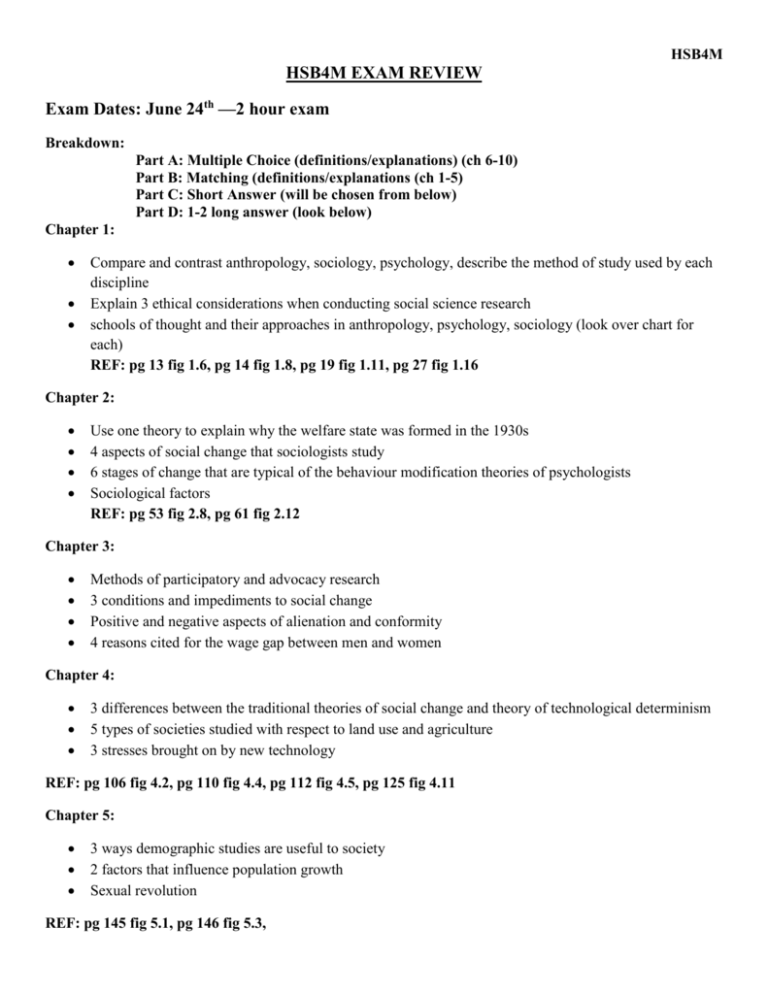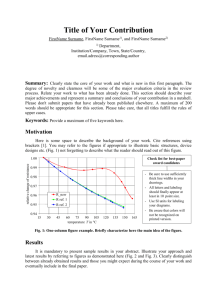File
advertisement

HSB4M HSB4M EXAM REVIEW Exam Dates: June 24th —2 hour exam Breakdown: Part A: Multiple Choice (definitions/explanations) (ch 6-10) Part B: Matching (definitions/explanations (ch 1-5) Part C: Short Answer (will be chosen from below) Part D: 1-2 long answer (look below) Chapter 1: Compare and contrast anthropology, sociology, psychology, describe the method of study used by each discipline Explain 3 ethical considerations when conducting social science research schools of thought and their approaches in anthropology, psychology, sociology (look over chart for each) REF: pg 13 fig 1.6, pg 14 fig 1.8, pg 19 fig 1.11, pg 27 fig 1.16 Chapter 2: Use one theory to explain why the welfare state was formed in the 1930s 4 aspects of social change that sociologists study 6 stages of change that are typical of the behaviour modification theories of psychologists Sociological factors REF: pg 53 fig 2.8, pg 61 fig 2.12 Chapter 3: Methods of participatory and advocacy research 3 conditions and impediments to social change Positive and negative aspects of alienation and conformity 4 reasons cited for the wage gap between men and women Chapter 4: 3 differences between the traditional theories of social change and theory of technological determinism 5 types of societies studied with respect to land use and agriculture 3 stresses brought on by new technology REF: pg 106 fig 4.2, pg 110 fig 4.4, pg 112 fig 4.5, pg 125 fig 4.11 Chapter 5: 3 ways demographic studies are useful to society 2 factors that influence population growth Sexual revolution REF: pg 145 fig 5.1, pg 146 fig 5.3, HSB4M Chapter 6: How does delaying childbirth affect fertility? 3 different reproductive technologies 4 stereotypes for those who choose to childlessness Chapter 7: 3 models of health care including the focus of each, the type provided and who is involved in controlling or managing each 3 reasons why adolescence was invented as a stage In a well-written paragraph, discuss Erikson’s stage of development theory. Indicate the adaptive and maladaptive outcome of the adolescent and young adulthood stages of development. Also indicate one criticism of his theory. In a well-written paragraph, explain three methods of socialization of adolescents. Chapter 8: 4 problems nurses are dealing with today 6 reasons why teenagers might start to smoke 3 reasons why some groups oppose the sale of baby formula, what does the manufactures say? Long answer: Explain 6 barriers to health care in Ontario today Chapter 9: How can I.Q. test be accused of discrimination 4 characteristics of hate crimes Group norm theory Why do children become less prejudiced as they grow older? Heritage front’s position on immigrants Know the difference between: stereotype, prejudice, discrimination, systemic discrimination, genocide Long answer: Explain using examples the difference between multiculturalism and anti-racism REF: pg 288 fig 9.1, pg 290 fig 9.2, pg 297 fig 9.4, pg 301 fig 9.8, pg 315 fig 9.15, Chapter 10: 3 groups that make up transnationalism 4 factors that influence perception World bank’s/council of Canadians’ position on globalization REF: pg 327 fig 10.1 HSB4M Multiple Choice/Matching Ch 1-5 Participant-observation Variable Kinship Institutions Binary opposite Dysfunctional Confederate Assimilationist Enculturation Longitudinal study Cognitive dissonance Operant conditioning Patriarchy Ch 6-10 Replacement level Barrenness Proximate determinant Disposable income Weaning Surrogate Menarche Superovulation Religiosity Initiation rite Informal support Identity diffusion Formal support Discourse Directed change Self-actualization Worldview Quintile Value-free LICO Anomie Pluralism Alienation Dominant paradigm Future shock Luddite Flood irrigation Pecuniary emulation Domestication Technosis Nomadic Generation Z Just society Recession Youthquake Dependency ratio Population pyramid Pension fund Separation-individuation process Granny flat Morbidity Social mores Domestic-scale culture Oncologist Attitude barrier Informed consent Folkway Embryo Anti-Semitism Paradigm shift Genocide Ethnocentrism Scapegoat War crimes White supremacist Subordinate cultures Sphere of influence SDI Transnational perceptual set Deterritorialization Memory modification Global village Financialization





